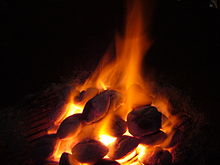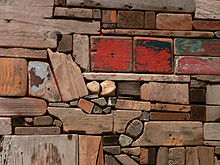Solid fuel

Solid fuel refers to various forms of solid material that can be burnt to release energy, providing heat and light through the process of combustion. Solid fuels can be contrasted with liquid fuels and gaseous fuels. Common examples of solid fuels include wood, charcoal, peat, coal, hexamine fuel tablets, dry dung, wood pellets, corn, wheat, rye, and other grains. Solid fuels are extensively used in rocketry as solid propellants.[1] Solid fuels have been used throughout human history to create fire[2] and solid fuel is still in widespread use throughout the world in the present day.[3][4]
Types of solid fuels[]
Wood[]
Wood fuel can refer to several fuels such as firewood, charcoal, wood chips sheets, pellets, and sawdust. The particular form used depends upon factors such as source, quantity, quality and application. In many areas, wood is the most easily available form of fuel, requiring no tools in the case of picking up dead wood, or few tools. Today, burning of wood is the largest use of energy derived from a solid fuel biomass. Wood fuel can be used for cooking and heating, and occasionally for fueling steam engines and steam turbines that generate electricity. Wood may be used indoors in a furnace, stove, or fireplace, or outdoors in a furnace, campfire, or bonfire. As with any fire, burning wood fuel creates numerous by-products, some of which may be useful (heat and steam), and others that are undesirable, irritating or dangerous. There is debate as to whether burning wood can be considered carbon neutral, as technically the wood cannot release more carbon than was sequestered during its growth, although this does not take account of other impacts such as deforestation and rotting has on the carbon footprint.[5] When harvested in a sustainable fashion wood is usually considered to be a renewable solid fuel.[6]
Biomass[]

Although wood is a form of biomass, the term usually refers to other natural plant material that can be burnt for fuel. Common biomass fuels include waste wheat, straw, nut shells and other fibrous material.[6]
Peat[]
Peat fuel is an accumulation of partially decayed vegetation or organic matter that can be burnt once sufficiently dried. It is used widely in the country districts of Ireland and Scotland where alternatives are absent or expensive. It has a relatively low calorific value, even after essential drying.
Coal[]
Coal is a combustible black or brownish-black sedimentary rock usually occurring in rock strata in layers or veins called coal beds or coal seams. Throughout history, coal has been used as an energy resource, primarily burned for the production of electricity and heat, and is also used for industrial purposes, such as refining metals. Coal is the largest source of energy for the generation of electricity worldwide, as well as one of the largest worldwide The extraction of coal, its use in energy production and its byproducts are all associated with environmental and health effects. Variations such as smokeless coal can be formed naturally in the form of anthracite, a metamorphosed type of coal with a very high carbon content that gives off a smokeless flame when set alight. It is an important type of smokeless fuel.
Coke[]
Coke is a fuel with few impurities and a high carbon content, usually made from coal. It is the solid carbonaceous material derived from destructive distillation of low-ash, low-sulfur bituminous coal. Cokes made from coal are grey, hard, and porous. While coke can be formed naturally, the commonly used form is man-made. The form known as petroleum coke, or pet coke, is derived from oil refinery coker units or other cracking processes.[6]
Smokeless fuel[]
Solid fuels which produce little smoke or volatiles are made from powdered anthracite coal and supplied in the form of briquettes usually for domestic use either in stoves or open fireplaces. The fuel is replacing coal as a fuel for open fires because of the reduction in particulate emissions and its increased efficiency. Smokeless fuel burns at a higher temperature and more slowly than a coal fire. The term also includes charcoal, made by restricted combustion of dry wood, is also widely used for open air barbecues with food cooked on an open fire.
Municipal waste[]
Municipal solid waste commonly known as trash or garbage in the United States and as rubbish in Britain, is a waste type consisting of everyday items that are discarded by the public. It can be burnt to create electrical energy by careful control of the waste stream. With the correct technology it can also be gasified and converted to a viable fuel source. However, this is technology heavy and can only be used where the waste is known not to contain toxic materials.[7]
Rocket propellant[]
Solid rocket propellant consists of a solid oxidizer (such as ammonium nitrate) bound with flakes or powders of energy compounds (such as RDX) plus binders, plasticizers, stabilizers and other additives. Solid propellant is much easier to store and handle than liquid propellant. It also has a higher energy density so it does not require as large of a space for the same amount of stored energy.
Calorific value[]
The heat available from each type of fuel is very variable, and depends on the carbon and hydrogen content, as well as non-combustible or ash and water content. One measure of the heat produced by burning is the Heat of combustion, an exact measure usually determined using bomb calorimetry and demanding complete combustion to carbon dioxide and water. Gaseous fuels like methane have higher values than solid fuels like coal, and peat exhibits the lowest value of all common fuels. Thus methane has an HHV (Higher heating value) of 55.50 MJ/kg, the highest value of common fuels. Diesel fuel has an HHV value of 44.80 MJ/kg and anthracite coal a value of 32.50 MJ/kg. Moisture and ash-free firewood has a lower value of 21.70 MJ/kg while dry peat has the lowest value of all common fuels of about 15.00 MJ/kg. These are somewhat ideal values and the actual heat realized by any fuel will depend on the fireplace or combustion chamber used and its design for example. But they do give a useful guide to the heat available from any fuel. Dry wood has roughly two thirds the calorific value of coal so a greater weight is needed to make the same amount of heat.
Benefits/disadvantages of solid fuel[]

Solid fuels, compared to liquid fuels or gaseous fuels, are often cheaper, easier to extract, more stable to transport and in many places are more readily available.[9][10] Coal, in particular, is utilized in the generation of 38.1% of the world’s electricity because it is less expensive than its liquid and gas counterparts. However, solid fuels are also heavier to transport, require more destructive methods to extract/burn and often have higher carbon, nitrate and sulphate emissions. With the exception of sustainable wood/biomass solid fuel is normally considered non-renewable as it requires thousands of years to form.[3]
Solid fuels are composed of organic materials and can contribute to poor air quality. The burning of solid fuels releases more organic aerosol[11] than liquefied petroleum gas and releases many volatile organic compounds, which can contribute to poor air quality through the formation of secondary pollutants such as ground level ozone and secondary organic aerosol.[12] The emissions from solid fuels are likely drivers of poor air quality in regions where solid fuels are a dominant fuel source, with volatile organic compound emissions from solid fuels significantly more reactive with the hydroxyl radical compared to those from liquefied petroleum gas.[13]
See also[]
References[]
- ^ "Solid". astronautix.com. Retrieved 2017-03-09.
- ^ "Evidence that human ancestors used fire one million years ago". Science Daily. 2012-04-02. Retrieved 2017-03-09.
- ^ Jump up to: a b "Coal". iea.org. Retrieved 2017-03-09.
- ^ "Coal consumption statistics - Statistics Explained". ec.europa.eu. Retrieved 2017-03-09.
- ^ Smith, K.R. (1993). "Greenhouse gases from biomass and fossil fuel stoves in developing countries: A Manila pilot study". Chemosphere. 26 (1–4): 479–505. Bibcode:1993Chmsp..26..479S. CiteSeerX 10.1.1.558.9180. doi:10.1016/0045-6535(93)90440-G.
- ^ Jump up to: a b c "Solid Fuels". Solid Fuel Technology Institute. 9 February 2014. Retrieved 22 June 2015.
- ^ [Wilson and Burgh. (2008). Energizing Our Future: Rational Choices For The 21st Century. New Jersey: John Wiley & Sons, Inc.]
- ^ Stewart, Gareth J.; Nelson, Beth S.; Acton, W. Joe F.; Vaughan, Adam R.; Hopkins, James R.; Yunus, Siti S. M.; Hewitt, C. Nicholas; Nemitz, Eiko; Mandal, Tuhin K.; Gadi, Ranu; Sahu, Lokesh K. (2021-02-25). "Comprehensive organic emission profiles, secondary organic aerosol production potential, and OH reactivity of domestic fuel combustion in Delhi, India". Environmental Science: Atmospheres. 1 (2): 104–117. doi:10.1039/D0EA00009D. ISSN 2634-3606.
- ^ "The Guide to Solid Fuels" (PDF). Solid Fuel Association. Retrieved 22 June 2015.
- ^ "Guide To Solid Fuel". Coal Products Ltd. Retrieved 22 June 2015.
- ^ Stewart, Gareth J.; Nelson, Beth S.; Acton, W. Joe F.; Vaughan, Adam R.; Farren, Naomi J.; Hopkins, James R.; Ward, Martyn W.; Swift, Stefan J.; Arya, Rahul; Mondal, Arnab; Jangirh, Ritu (2021-02-18). "Emissions of intermediate-volatility and semi-volatile organic compounds from domestic fuels used in Delhi, India". Atmospheric Chemistry and Physics. 21 (4): 2407–2426. Bibcode:2021ACP....21.2407S. doi:10.5194/acp-21-2407-2021. ISSN 1680-7316.
- ^ Stewart, Gareth J.; Acton, W. Joe F.; Nelson, Beth S.; Vaughan, Adam R.; Hopkins, James R.; Arya, Rahul; Mondal, Arnab; Jangirh, Ritu; Ahlawat, Sakshi; Yadav, Lokesh; Sharma, Sudhir K. (2021-02-18). "Emissions of non-methane volatile organic compounds from combustion of domestic fuels in Delhi, India". Atmospheric Chemistry and Physics. 21 (4): 2383–2406. Bibcode:2021ACP....21.2383S. doi:10.5194/acp-21-2383-2021. ISSN 1680-7316.
- ^ Stewart, Gareth J.; Nelson, Beth S.; Acton, W. Joe F.; Vaughan, Adam R.; Hopkins, James R.; Yunus, Siti S. M.; Hewitt, C. Nicholas; Nemitz, Eiko; Mandal, Tuhin K.; Gadi, Ranu; Sahu, Lokesh K. (2021-02-25). "Comprehensive organic emission profiles, secondary organic aerosol production potential, and OH reactivity of domestic fuel combustion in Delhi, India". Environmental Science: Atmospheres. 1 (2): 104–117. doi:10.1039/D0EA00009D. ISSN 2634-3606.
Further reading[]
- "CO2 Emissions (metric tons per capita)." Data. N.p., n.d. Web. 25 March 2014.
- "Coal Facts." Coal Facts. N.p., n.d. Web. 25 March 2014.
- "Heating Options for Your Home Buying Guide." Electricity, Gas or Solid Fuel? - CHOICE Reviews Heating Options for Your Home. N.p., n.d. Web. 25 March 2014.
- Solid fuels